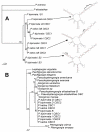Phenotypic plasticity and morphological integration in a marine modular invertebrate
- PMID: 17650324
- PMCID: PMC1959521
- DOI: 10.1186/1471-2148-7-122
Phenotypic plasticity and morphological integration in a marine modular invertebrate
Abstract
Background: Colonial invertebrates such as corals exhibit nested levels of modularity, imposing a challenge to the depiction of their morphological evolution. Comparisons among diverse Caribbean gorgonian corals suggest decoupling of evolution at the polyp vs. branch/internode levels. Thus, evolutionary change in polyp form or size (the colonial module sensu stricto) does not imply a change in colony form (constructed of modular branches and other emergent features). This study examined the patterns of morphological integration at the intraspecific level. Pseudopterogorgia bipinnata (Verrill) (Octocorallia: Gorgoniidae) is a Caribbean shallow water gorgonian that can colonize most reef habitats (shallow/exposed vs. deep/protected; 1-45 m) and shows great morphological variation.
Results: To characterize the genotype/environment relationship and phenotypic plasticity in P. bipinnata, two microsatellite loci, mitochondrial (MSH1) and nuclear (ITS) DNA sequences, and (ITS2) DGGE banding patterns were initially compared among the populations present in the coral reefs of Belize (Carrie Bow Cay), Panama (Bocas del Toro), Colombia (Cartagena) and the Bahamas (San Salvador). Despite the large and discrete differentiation of morphotypes, there was no concordant genetic variation (DGGE banding patterns) in the ITS2 genotypes from Belize, Panama and Colombia. ITS1-5.8S-ITS2 phylogenetic analysis afforded evidence for considering the species P. kallos (Bielschowsky) as the shallow-most morphotype of P. bipinnata from exposed environments. The population from Carrie Bow Cay, Belize (1-45 m) was examined to determine the phenotypic integration of modular features such as branch thickness, polyp aperture, inter-polyp distance, internode length and branch length. Third-order partial correlation coefficients suggested significant integration between polypar and colonial traits. Some features did not change at all despite 10-fold differences in other integrated features. More importantly, some colonial features showed dependence on modular features.
Conclusion: Consequently, module integration in gorgonian corals can be shifted, switched or canalized along lineages. Modular marine organisms such as corals are variations on a single theme: their modules can couple or decouple, allowing them to adapt to all marine benthic environments.
Figures




Similar articles
-
Patterns of morphological integration in marine modular organisms: supra-module organization in branching octocoral colonies.Proc Biol Sci. 2003 Oct 7;270(1528):2039-44. doi: 10.1098/rspb.2003.2471. Proc Biol Sci. 2003. PMID: 14561292 Free PMC article.
-
Morphological plasticity in scleractinian corals.Biol Rev Camb Philos Soc. 2008 Aug;83(3):315-37. doi: 10.1111/j.1469-185x.2008.00045.x. Biol Rev Camb Philos Soc. 2008. PMID: 18979594 Review.
-
A case of modular phenotypic plasticity in the depth gradient for the gorgonian coral Antillogorgia bipinnata (Cnidaria: Octocorallia).BMC Evol Biol. 2017 Feb 17;17(1):55. doi: 10.1186/s12862-017-0900-8. BMC Evol Biol. 2017. PMID: 28212607 Free PMC article.
-
Incipient speciation across a depth gradient in a scleractinian coral?Evolution. 2002 Nov;56(11):2227-42. doi: 10.1111/j.0014-3820.2002.tb00147.x. Evolution. 2002. PMID: 12487353
-
The role of sponges in the Mesoamerican Barrier-Reef Ecosystem, Belize.Adv Mar Biol. 2012;61:211-71. doi: 10.1016/B978-0-12-387787-1.00002-7. Adv Mar Biol. 2012. PMID: 22560779 Review.
Cited by
-
Environmental influences on the Indo-Pacific octocoral Isis hippuris Linnaeus 1758 (Alcyonacea: Isididae): genetic fixation or phenotypic plasticity?PeerJ. 2015 Aug 20;3:e1128. doi: 10.7717/peerj.1128. eCollection 2015. PeerJ. 2015. PMID: 26312170 Free PMC article.
-
A time-calibrated molecular phylogeny of the precious corals: reconciling discrepancies in the taxonomic classification and insights into their evolutionary history.BMC Evol Biol. 2012 Dec 18;12:246. doi: 10.1186/1471-2148-12-246. BMC Evol Biol. 2012. PMID: 23249327 Free PMC article.
-
Not out of the Mediterranean: Atlantic populations of the gorgonian Paramuricea clavata are a separate sister species under further lineage diversification.Ecol Evol. 2023 Jan 29;13(1):e9740. doi: 10.1002/ece3.9740. eCollection 2023 Jan. Ecol Evol. 2023. PMID: 36789139 Free PMC article.
-
Molecular evolution of rDNA in early diverging Metazoa: first comparative analysis and phylogenetic application of complete SSU rRNA secondary structures in Porifera.BMC Evol Biol. 2008 Feb 27;8:69. doi: 10.1186/1471-2148-8-69. BMC Evol Biol. 2008. PMID: 18304338 Free PMC article.
-
A next generation approach to species delimitation reveals the role of hybridization in a cryptic species complex of corals.BMC Evol Biol. 2019 Jun 6;19(1):116. doi: 10.1186/s12862-019-1427-y. BMC Evol Biol. 2019. PMID: 31170912 Free PMC article.
References
-
- Magwene PM. New tools for studying integration and modularity. Evolution. 2001;55:1734–1745. - PubMed
-
- Lasker HR, Sánchez JA. Allometry and Astogeny of modular organisms. In: Hughes RN, editor. Reproductive Biology of Invertebrates Progress in Asexual Reproduction. XI. New York: John Wiley; 2002. pp. 207–253.
-
- Sánchez JA, Lasker HR. Patterns of Morphologic Integration in Branching Colonies of Marine Modular Organisms: supra-module organization in Gorgonian Corals. Proceedings of the Royal Society of London B. 2003;270:2039–2044. doi: 10.1098/rspb.2003.2471. doi: DOI: 10.1098/rspb.2003.2471. - DOI - PMC - PubMed
-
- Sánchez JA. Evolution and dynamics of branching colonial form in marine modular Cnidarians: Gorgonian Octocorals. Hydrobiologia. 2004;530:283–290. doi: 10.1007/s10750-004-2684-2. - DOI
Publication types
MeSH terms
Substances
LinkOut - more resources
Full Text Sources
Other Literature Sources

